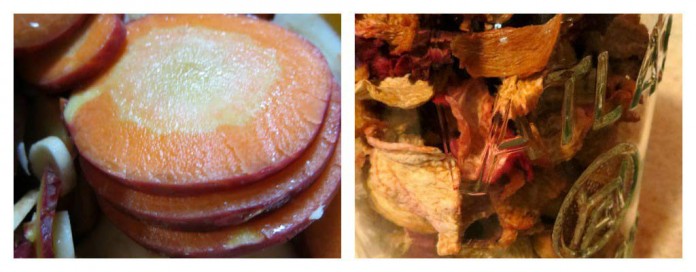Canning and freezing are the most common methods of food preservation, but dehydrating fruits, vegetables and herbs is an efficient and healthy way to preserve your garden’s bounty.
- Dried food takes up less space than jars and freezer containers.
- Dried food is lightweight and great to pack for snacks.
- Dehydrating removes food’s natural moisture. Less moisture decreases the likelihood of food spoilage in storage.
- Drying food at a low temperature retains valuable vitamins and nutrients.
- Dehydration is a wise way to preserve food without salt or other preservatives.
How to dehydrate food
Dehydration requires heat and air movement. The sun, an oven or a dehydrator can accomplish the task. A food dehydrator is advantageous because it allows better temperature control and ensures constant air flow.
Step 1: Start with ripe fruit or mature vegetables. Wash well. Remove seeds, stems and pits. Cut off and discard blemished portions.
Step 2: Slice foods to the same thickness.
Step 3 (optional): Blanching herbs and vegetables in boiling water or steam and immediately cooling in an icy cold water bath kills spoilage organisms and promotes better color and texture. Blanching also shortens dry time. Fruits can be dipped in ascorbic or citric acid in place of blanching.
Step 4: Lay food on dehydrator trays in a single layer. Fill the dehydrator with like foods, such as all apples or all berries, for more consistent results. Do not interrupt a cycle to add more food or additional trays to the dehydrator.
Step 5: Choose the right temperature. Herbs dry best around 95 degrees F, vegetables 125 degrees F and fruits 135 degrees F.
Step 6: Mark time. The larger the exposed surface area, the faster food dries. Increasing the temperature does not necessarily make food dry faster. Too high of temperature will rob food of nutrients and ruin its texture.
Step 7: Store dehydrated food in airtight containers such as Tupperware, Ziplocs, mason jars or vac packs to keep food moisture-free and safe from pests. If stored properly, dried food keeps well for 1-3 years.
My Foodsaver vacuum sealer has an accessory that allows me to seal dry foods in mason jars. The accessory costs $9.99 and is available in both regular and wide mouth. When the lid pops inward I know I have a perfectly airtight seal. I believe it’s a superior way to store dry foods.
Step 8: Use food dry or rehydrate it with reconstitution. To reconstitute, soak dried food in water for 8-12 hours in the refrigerator. Reconstituting dried food doubles its size. Use the soaking water to cook the reconstituted food to achieve full flavor.
Dehydrated garden goodies
- Dehydrate herbs to make herbal tea blends. Mint, lemon balm, chamomile, lemon grass and lavender are a few of my favorites. To zest up herbal tea blends, add dried fruit like orange and lemon peels. Dried apple also makes a fragrant fall-tasting tea.
- Make vegetable chips by slicing root vegetables like beets, parsnips and carrots very thin with a mandoline slicer. Toss sliced vegetables in a bowl with 3:1 vinegar to oil. Drain well. Sprinkle with sea salt. Dehydrate at 125 degrees F. Vegetable chips can be eaten as snacks or reconstituted in winter soups and stews.
- Reconstitute fruit and add it to prepared pancake batter or a box of quick bread or muffin mix.
More about food preservation
- How to safely can food: 4 tips for home food preservation May 19, 2015
- Fermentation, the other preservation Nov. 7, 2014
- Preserving food with boiling water canning and pressure canning Aug. 12, 2014













